BMW Engine Oil Level Low Below Minimum Warning
Posted on
Updated on
When the BMW engine reaches a critically low oil level, the oil level below the minimum warning comes on.
Continuing to drive a BMW after it displays the engine oil level low or below minimum or oil pressure too low can cause engine damage.
This message is critical and means the engine does not have enough oil to operate properly. See the instructions below on how to check the oil level and add engine oil.
Do not drive a BMW with no oil or low oil level, as this can cause excessive engine wear even in as little as 10 or 15 minutes.
Pull over immediately, check the oil level, and add engine oil as needed. The easiest way to find which oil to use on your BMW is to open the hood and look at the sticker on top of the radiator, under the hood itself, or on the oil cap.
Regardless of the oil brand, it is critical to have oil in the engine and have the oil warning light turn off rather than drive with the oil light on.
Use BMW-approved oils (LL01, LL02) for your engine when possible. In most cases, it will be 0W-40, 5W-30, or 5W-40 full synthetic. BMW recommends Castrol, but you can use any BMW-approved long-life oil as specified in LL01 or LL04 sheets, including Castrol, Elf Excellium, Galp Energy, Liqui Moly, Mobil 1, Motul, Oest, Pennzoil, etc.
If the recommended oil is unavailable, use conventional oil and then get an oil change and use the correct oil in the next two weeks.
How to check/add oil on a BMW.
- Park the vehicle on level ground, and turn off the engine.
- Wait for at least ten minutes. This allows the oil to return to the oil pan for an accurate measurement.
- Pull the hood release under the dashboard on the driver’s side. Some models require you to pull the hood lever twice for the hood to release.
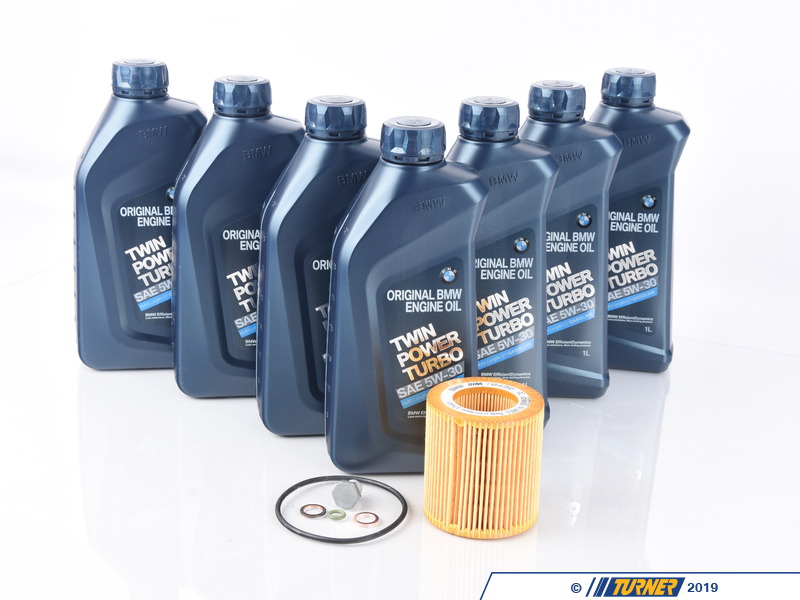 If that’s the case, the hood level will have x2 on printed on top.
If that’s the case, the hood level will have x2 on printed on top. - Go to the front of the vehicle and release the hood latch. Ensure the hood stays up on its own. If the hood supports are too weak, the hood will shut down. If that’s the case, have someone hold the hood open for you.
- Locate the oil dipstick and pull it out. The oil dipstick is on the side of the engine and usually has a yellow handle. Some BMWs do not have an oil dipstick. In those models, you check the engine oil level via the dashboard.
- Wipe the oil dipstick with a lint-free cloth; note the hatched area on the dipstick. This indicates the MIN and MAX range.
- Reinsert it into the oil dipstick tube.
- Pull out the dipstick again and note the oil level. It should be between the MIN and MAX marks.
- If the level is below the MIN level, remove the oil cap by turning it counterclockwise, add one quart or one liter of oil and recheck the level. To raise the oil level from the MIN to the MAX mark, you need about one quart of oil.
 Do not overfill above the MAX mark.
Do not overfill above the MAX mark. - If you rectified the oil level, but the oil level or oil pressure warning light remains on, do not drive the vehicle. Call your auto mechanic and ask for advice. The vehicle may need to be towed to a BMW dealer or mechanic shop.
What oil should I use?
When adding oil to a BMW, it is essential to use the oil recommended by BMW. BMW recommends using Castrol 0W-40 full synthetic in most models. Check the owner’s manual and verify.
There are two ways to find which oil to use on a particular BMW. The easiest way is to open the hood and look at the sticker on top of the radiator support or under the hood.
The second method is to look it up in your owner’s manual. BMW-approved oils specification sheets are designated with LL01, LL04, etc.
BMW shows an oil level warning, but the oil level is correct
You may check the engine oil level using the dipstick and find that the oil level is correct. In such cases, the problem could be either a problem with the oil pump, which can cause low oil pressure, or a faulty oil pressure sensor.
Do not drive your BMW with the oil light warning for days, weeks, or months. If the oil pressure is low, that is a severe problem that needs to be fixed immediately. The engine may run and drive fine if faulty oil pressure sensor. Get the sensor replaced as soon as possible.
The challenge is to find out which one is the problem. You or your auto mechanic should perform an oil pressure test and check the resistance of the oil pressure sensor with a digital multimeter.
I can’t find the correct oil. Should I wait until tomorrow?
Having the correct oil level is more important than having no or low oil. Let’s say the oil light comes on while you are on a long trip. You stop at an auto parts store, but they do not have the recommended oil.
Should you drive with the oil light or use an alternative oil? Using substitute oil is better than driving with low or no oil.
Driving with low oil can lead to excessive and rapid premature engine wear. If the recommended oil is unavailable, it is ok to use 5W-30. Once you make it home, you can change your BMW engine oil and use the recommended oil. Do not drive with the oil light on or a low oil warning.
Once you make it home, you can change your BMW engine oil and use the recommended oil. Do not drive with the oil light on or a low oil warning.
BMW Oil Warning Messages
- Engine oil pressure! Stop carefully. Engine oil pressure is too low—possible engine damage. Switch off the engine. Continued during is not possible. Please contact the nearest BMW center.
- Engine oil level. Oil level below minimum. Continued driving may cause engine damage. Check and add oil as required as soon as possible. Refer to the owner’s manual.
- Engine oil level above maximum. For important information, see the owner’s handbook. (In this case, the engine oil level is too high, and some oil needs to be removed to bring the story between the MIN and MAX levels.
- Engine oil at a minimum level. Add 1 quart of oil as soon as possible. See owner’s manual.
- Engine oil at the minimum level. Please add 2 quarts of engine oil.

- Engine oil level at minimum. Top up 1 liter of oil at the earliest opportunity. See owner’s handbook. Then measure the engine oil level.
- Engine oil level below minimum. Please add 1 quart of engine oil immediately.
- Engine oil level below minimum. At the next opportunity, top up with 1 liter of engine oil. See owner’s handbook.
We hope you find the BMW Engine Oil Level Low Below Minimum Warning guide helpful. Check these troubleshooting and repair guides for more help on your BMW.
BMW Engine oil At Minimum Level Issues & How to Test BMW Oil Level Sensor – AutoVfix.com
Sharing is caring!
0
shares
Last updated on June 28th, 2023 at 07:59 am
Is your BMW engine oil at minimum level? What can you do
about it? Well, in this post we are going to look at all about BMW engine oil
at minimum level.
So we will be discussing and responding to some of the common questions on BMW oil level like how to test BMW oil level sensor, where is the BMW oil level sensor location and how does BMW oil level sensor work.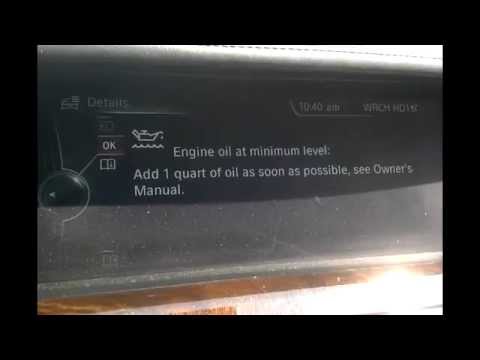
Also, we will provide the answer to this frequent question: “what oil does my BMW car need?” while discussing the Symptoms of a Bad Low Oil Level Sensor for BMW Related Article:How to Change, Cost & Where to Buy BMW i3 12V Battery
BMW Engine Oil At Minimum Level Issues & How to Test BMW Oil Level Sensor
BMW cars are equipped with electronic engine oil level
monitoring sensor that irradiates, and this light does not necessarily mean
your oil needs to be changed that is a common misreading amongst BMW owners.
When this light comes on, it means your engine oil is at least 1 quart/liter
low.
There are three possible factors that may cause the light to
irradiate:
- oil leaks
- oil consumption that cause oil loss
- Defective oil level sensors common on older models
Some BMW owners have noticed a warning light come on for the
engine level when their BMW engine oil is at minimum level.
When this is noticed, they begin to wonder if they should
take their car to a dealer for a top off, or if they can simply buy 1 quart of
BMW engine oil and top it up themselves.
Oil level tends to drop between changes with BMW’s factory overstretched oil change interval. The rate of oil consumption is typical for any engine in different amounts. Normally, BMW holds a 1 quart/liter per 1,000miles maximum for normal oil consumption; a value that is still high on consumption. However, with the newer turbo charged BMW engine, the rate of oil consumption has increased further due to higher pressure of cylinder.
It got to the extent that BMW released a service bulletin for
the F01, F02, F06, F10, F12, F13, E70, and E71 fitted with the N63 & N63T,
increasing the oil fill/top off amount to lengthen the amount of time before low
oil level light comes on.
A BMW driver who notices the low oil warning light, they should use Mobil 1 Extended 5W30 Full Synthetic oil for topping off. If the low oil light comes on and your BMW doesn’t have a measuring stick, then add 1 quart/liter of oil and recheck oil level indicator through the instrument cluster/iDrive. However, if your BMW has a measuring stick or a dipstick, you can visually confirm proper fill level and add oil.
However, if your BMW has a measuring stick or a dipstick, you can visually confirm proper fill level and add oil.
Symptoms of a Bad Low Oil Level Sensor for BMW
The main thing that keeps your engine running strong for thousands of miles is the oil.
All combustion engines, including those of BMW, need a specific
amount of oil that will circulate through the engine to ensure the metal parts
are properly lubricated irrespective of the type of motor.
Metal components will heat, break and in the long run cause
severe damage inside the motor to render it unworkable.
The aim of fixing the oil level sensor is to warn drivers that
their engines need extra motor oil to function properly.
The oil level sensor is positioned inside the oil pan, and its main
job is to measure the amount of oil inside the pan before the engine is
started.
The low oil level will trigger a warning light indicator on the dashboard, which will light up the check engine light.
However, it can wear out or send wrong data to the engine
control unit (ECU), since it’s exposed to extreme heat and harsh conditions.
Failure of the oil level sensor will trigger an alert or error
code inside the ECU and warn the driver that there’s a problem.
However, there are other warning signs to indicate a problem with
the oil level sensor.
Let’s look at some major symptoms of a failing or bad oil
level sensor
1. Oil Light comes on frequently
This is one potential indicator that there’s a problem with your
oil level sensor. You will notice that the light comes on intermittently.
The oil level sensor should normally come on as soon as you
start your motor, and as the data is collected while the motor is turned off.
But when your BMW car is in motion and this warning light comes
on and has started for a while, it could mean the sensor is bad, failing, or
damaged.
This warning sign could also point to a problem with the
pressure of the engine oil.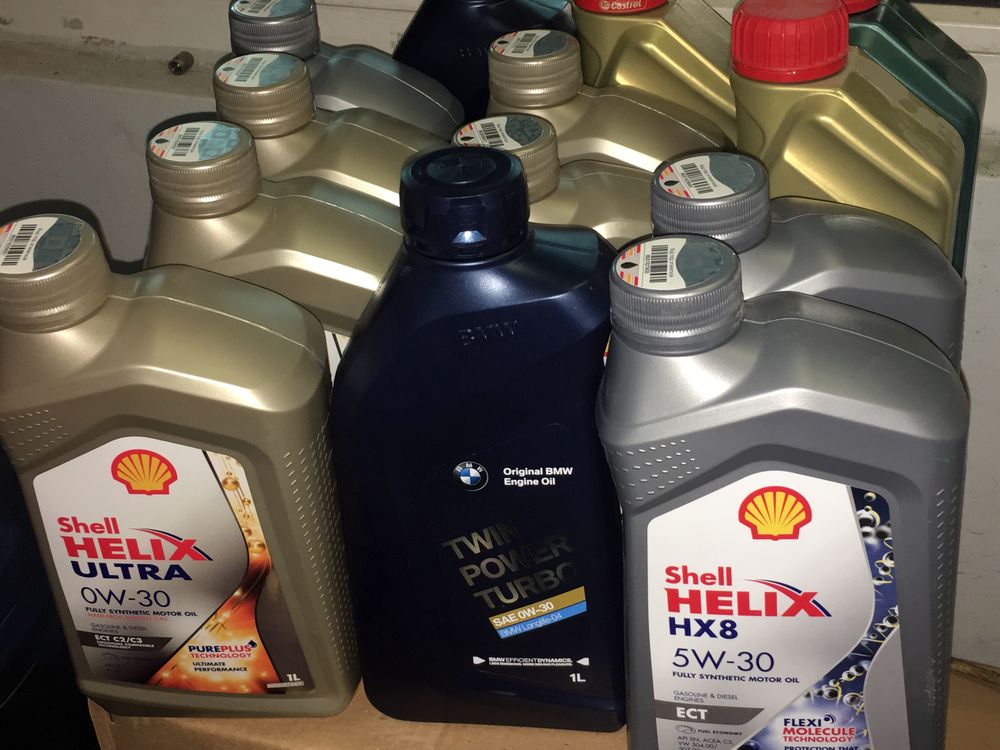 It could even indicate that the oil lines are clogged
It could even indicate that the oil lines are clogged
by debris.
2. Check Engine Light comes on
If the oil level sensor is functioning properly, the oil light will
be triggered to come on your vehicle when the oil level is low.
It’s also common for it to activate the check engine light if
the sensor is damaged or defective.
Consult the services of an experienced mechanic when the check
engine light comes on.
3. Inaccurate oil reading
The oil level sensor warns the driver that the engine is low on oil inside the crankcase. However, when the sensor is faulty, it may incorrectly activate this information.
Most BMW car owners check their oil level manually after the
alert is shown on the dashboard. If the oil on the dipstick is above the
“add” line, it means that the oil sensor is broken or that there’s a
problem where the sensor system is.
This symptom should never be disregarded because low oil
pressure or blockage in the lines can lead to complete engine failure.
Contact a local mechanic when you notice this issue to avoid damage
to the components of the internal engine.
4. Car does not start
The oil level sensor is intended to be an alert only device. However,
faulty data from the sensor may trigger the incorrect error code and trigger
the ECU of the engine not to allow the engine to start.
In this case, it is advisable to call a mechanic to detect why
your engine refuses to start. Your mechanic should download this error code and
fix the issue by replacing the oil level sensor
Every time you start your engine, always ensure that your engine
has proper levels of oil, pressure and that the oil is clean.
If you notice any of the above symptoms, you’re your mechanic for a proper check to avoid causing additional damage to your engine.
With these in mind let’s look at how to test BMW oil level sensor
How
to Test BMW oil Level Sensor
You can test the oil level sensor of a BMW car using an Innova 3310 Digital Multimeter, which you can this on Amazon. The sensor has 3 prongs and someone who doesn’t have a knowledge of how to take the readings may not be able to test it. Maybe someone is kind enough to explain when you would test something for Resistance
The sensor has 3 prongs and someone who doesn’t have a knowledge of how to take the readings may not be able to test it. Maybe someone is kind enough to explain when you would test something for Resistance
There s/b, a finite resistance between pins 1 and 2 and the sensor may still be faulty even with this reading. The TIS method mentions the use of BMW computers DIS or MoDIC. The test procedure for the BMW oil level sensor measures the sensor’s cool-down time.
If the dipstick indicates full, and you’re getting a Low Oil reading, replace the sensor. It may require you to drain the oil, and replace the O-ring.
Continuity doesn’t measure resistance, it is used to check if a circuit is continuous, and not broken. For instance, it is used to check an electrical fuse to confirm if it is really blown.
Resistance on the other hand measures the impeding current flow. The resistance element heats the sensor in the case of the level sensor.
To check if a diode is defective, you use the diode test.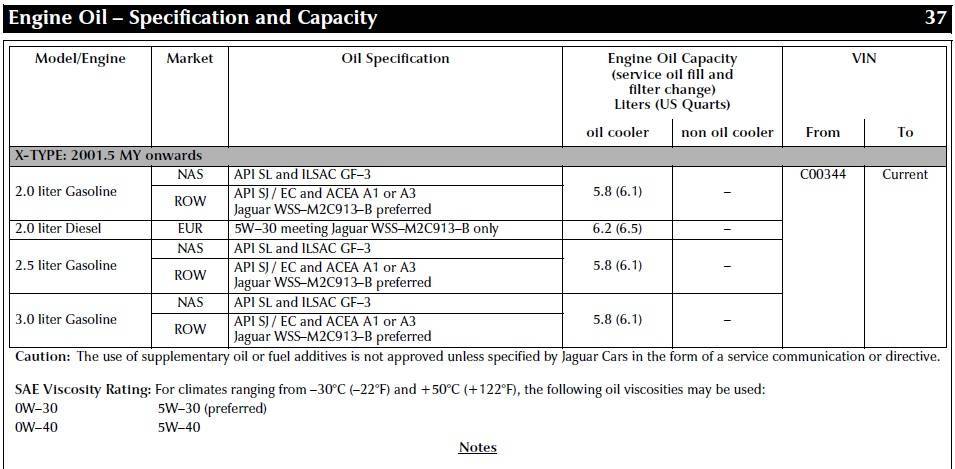 One polarity measures the junction voltage, and the other displays nothing, this indicates that the diode is functioning.
One polarity measures the junction voltage, and the other displays nothing, this indicates that the diode is functioning.
Note on How to Test BMW oil Level Sensor
Always check oil level with dipstick and don’t assume the sensor is faulty and forget to check the dipstick. Also, the oil level sensor usually has an open circuit, meaning when the oil level is good, the resistance across the pins is infinity. So linking the connector does not always work because this creates a “Low Oil Condition”. Disconnect the sensor instead.
BMW
have currently eliminated oil level dipstick and have replaced it with a sensor
in the oil pan. The sensor is to alert you if the oil level drops below the
safe level inside the oil-pan. The engineers who designed the engines
calculated the amount.
BMW
designed it in such a way that you can drive your car 15,000 miles before
changing the engine oil and without using your transmission oil. You can run
out of oil in your oil-pan at every 8,000 miles.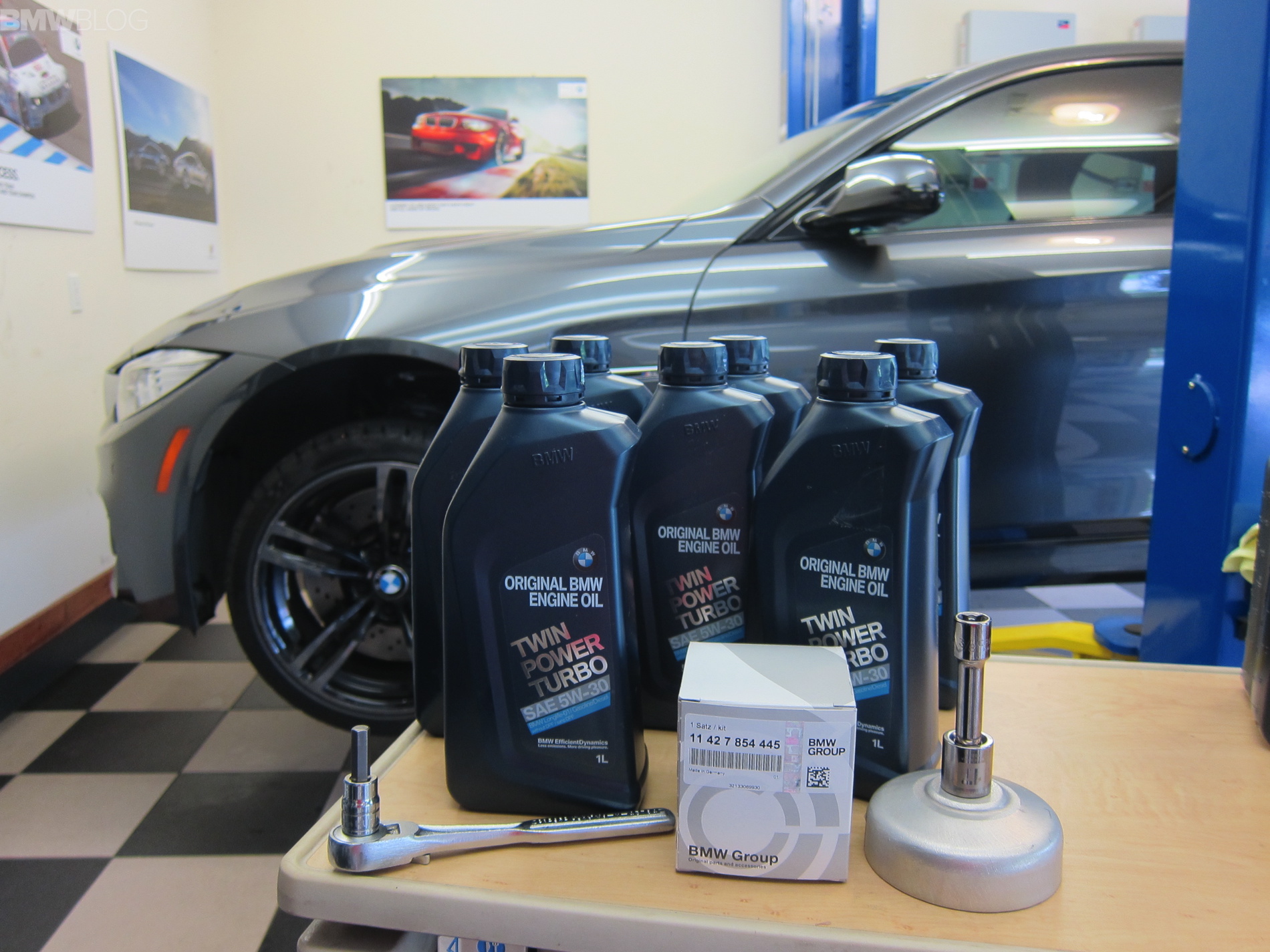 This is about half the
This is about half the
recommended interval of 15,000-mile oil change.
How
Does the BMW Oil Level Sensor Work?
The BMW
oil level sensor uses the lower
capacitor to measure the quality of the oil and the upper capacitor is
used to determine the level of the oil. The dielectric sensor measures the
dielectric value of the oil against
a dielectric constant value to decide the level of contamination of
the oil.
Mechanical dipsticks to check the oil level sensor on BMW are direct-read devices, meaning, the level of the engine oil in the crankcase is determined by the presence of oil on the dipstick. The e-dipstick device takes data and data analysis to decide the oil level. This means that it takes time to determine the oil level.
The oil must be at the operating temperature before you can obtain an accurate oil level reading. This is one of the reasons the OZS has a temperature sensor built into it and the engine must have been in operation for a minimal time period and gone through a succession of operational parameters to ensure oil has moved all through the lubrication system while the engine is running. The engine operating temperature must be above a minimum of 140 deg. F.
The engine operating temperature must be above a minimum of 140 deg. F.
The engine speed must have reach greater than 1,000 RPM, and the engine must have reached acceleration levels transverse and longitudinal of greater than 12 – 15 feet per-second squared. It takes 5 minutes to reach these parameters and the e-dipstick will not provide a measurement until the time is reached. This is the reason why a small clock symbol appears in the e-dipstick window with no reading, if the engine is cold. The e-dipstick updates to a new level reading once the time and other parameters are met. The engine computer monitors the oil level continuously and updates the e-dipstick display every 20 minutes.
What Oil Does my BMW Car Need?
If You are always confused as to which oil to oil to use
for your BMW car, well I will advise you stick to BMW recommended oil and below
are the top 2 BMW recommended oil to get for your car.
The 2 BMW recommendations are:
- Pennzoil Synthetic Motor oil
- BMW Twinpower 5W30 Synthetic
Pennzoil Synthetic Motor
oil
This oil, which is produced from natural gas, keeps pistons about 65 percent cleaner than what is obtainable by the industry standard. Pennzoil oil also produces better protection from friction. Another outstanding quality of Pennzoil synthetic motor oil that gives it an edge over others is that it provides faster low-temperature oil flow, which protects the engine from extreme heat and protects the engine from loss of power.
Pennzoil oil also produces better protection from friction. Another outstanding quality of Pennzoil synthetic motor oil that gives it an edge over others is that it provides faster low-temperature oil flow, which protects the engine from extreme heat and protects the engine from loss of power.
You can buy Pennzoil Synthetic Motor oil on Amazon
BMW Twinpower 5W30 Synthetic
BMW Company specifically formulated this oil for BMW
engines and has active cleansing technology. BMW Twinpower oil, unlike other
synthetic oils, can withstand heat and cold. This oil helps preserve your
engine in the best possible condition and can bear great engine loads and
boosts protection and performance for both turbocharged and non-turbocharged
engines.
You can buy BMW Twinpower 5W30 Synthetic on Amazon
However, you may be using oil that meets BMW specification,
ensure you check for details properly.
Other oils that meets BMW specifications include:
- Valvoline SynPower 5W-30 Full Synthetic Motor oil
- Castrol 03084 EDGE 5W-30 Advanced Synthetic Motor oil
- Mobil 1 Full Synthetic Motor Oil OW-30 Specification
- BMW 3 series 2008 Review
Where is the Location for the BMW Oil Sensor?
BMW models use an oil condition sensor
located in the oil pan.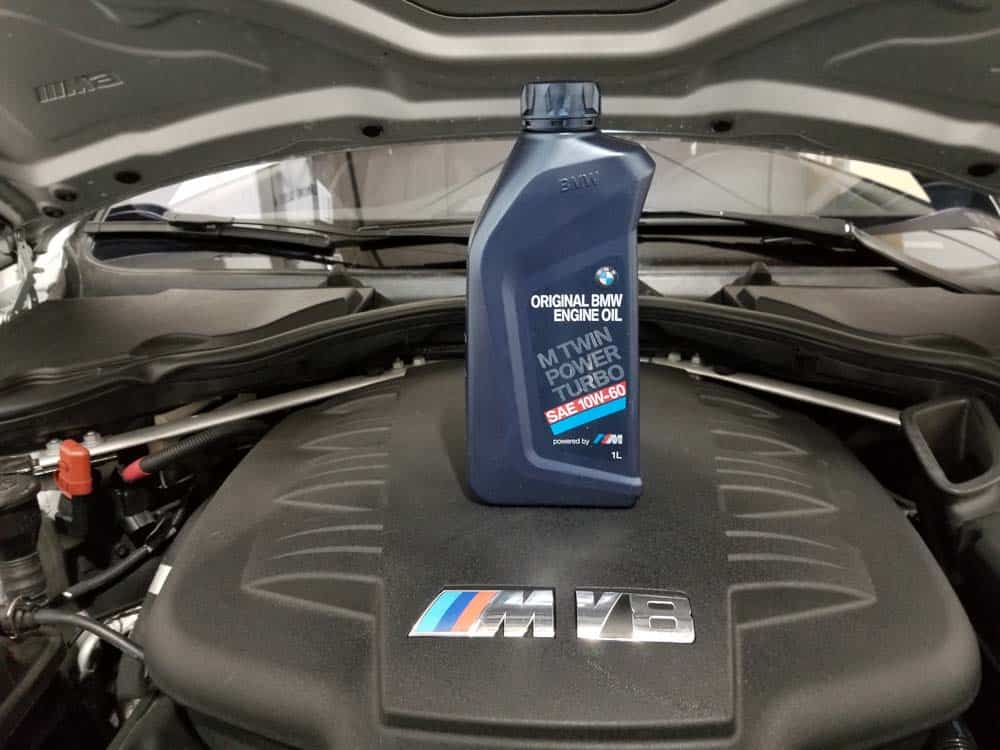
This sensor is responsible
for supplying oil level
and oil condition
information to the vehicle computer system.
BMW E90 models mostly use this sensor in place of a dipstick to check the oil level.
You can also monitor the oil level through the driver information centre.
The sensor is susceptible to failure because it can develop electrical
faults and it can also leak oil.
When it develops electrical issues, the driver will notice a yellow oil warning light on the instrument panel.
If a yellow oil warning light illumes on your instrument panel, then you have to shut the engine off and level of engine oil. The sensor may have failed if you notice that the oil level is OK and the warning light is ON. The DME or engine control module will likely have a fault code for the defective sensor.
You should use a container to drain and catch dripping engine oil when servicing. Have rags to properly clean any engine oil that is spilt and always use gloves and
I hope
this post has helped you with your BMW engine oil at minimum level
concerns and you were able to see how to test BMW oil level sensor and know
where your BMW oil level sensor location is.
I am sure you now know what oil your BMW car needs and how BMW oil level sensor work
How to Change BMW I3 Battery Replacement Cost & Where to Buy BMW i3 12V Battery
Jeffery Ekweghi
Hi dear, my name is Jeffery Ekweghi, and I am a certified mechanic and autobody parts technician. I created this site to share my expertise and experience with car lovers looking to resolve their car-related issues. I am certified in private cars and heavy-duty commercial vehicles. I have worked as a mechanic since 2015 and have experience in vehicle brands like Subaru, Jeep, Toyota, TATA, BMW, Mazda, Honda, Nissan, Kia, TVs, and Others; however, I primarily specialize in Toyota vehicles.
Sharing is caring!
0
shares
Oil at a minimum — can I go? Yes! But … — magazine Behind the wheel
The expert answered the most tricky (and important) questions regarding the choice and replacement of oil.
Which oil should I buy?
Pour domestic oil into a foreign car — 2 warnings
The main criterion is the oil quality class. Although not all owners have any idea what kind of oil he has filled.
Although not all owners have any idea what kind of oil he has filled.
General tip: for fresh cars will work with any SP oil. It is the most advanced to date and is fully compatible with previous products — SN, SM and simpler.
Anything can be filled into old cars: no one sells absolutely ancient oils now. The brand does not play a special role: all modern oils in the certification process are tested for compatibility with other brands of oils.
The fine for driving without OSAGO will increase (but not for everyone) The best way to save your nerves and money is to subscribe to your favorite magazine Loud emergency in Russia: did the human factor fail or did the technology fail?
Which viscosity is best?
Servicemen most often fill engines with 5W-30 oils, considering this viscosity to be universal. Most modern engines are designed for oils with a viscosity of 0W-20. These engines feature a compact design and narrow oil passages that thicker oils may not pass through. At the same time, low-viscosity oil somewhat reduces fuel consumption.
At the same time, low-viscosity oil somewhat reduces fuel consumption.
But for motors with relatively large clearances, whether they are structurally old or just heavily worn engines, such oils, on the contrary, will be harmful. Oil pumps will not create the necessary pressure, the necessary oil film between the rubbing parts will not arise, and oil starvation will quickly kill the engine.
For reference : low viscosity oils should not be used in engines below the third environmental class.
Whatever car you have, be sure to carry a supply of engine oil with you. Best of all — a liter package.
Do I need to bring oil with me?
Here are some obvious reasons to put a liter can of oil in the trunk.
- Modern engines use more oil than older engines. An increased compression ratio, an increase in effective pressure in the cylinders — all this increases the likelihood of a breakthrough of gases through the piston rings into the crankcase ventilation, and from there into the combustion chamber.
 Turbocharging also affects: even with a new turbocharger, a certain amount of oil enters the compressor part, and from there into the cylinders. Therefore, the need to add oil before a scheduled visit to the service is quite likely.
Turbocharging also affects: even with a new turbocharger, a certain amount of oil enters the compressor part, and from there into the cylinders. Therefore, the need to add oil before a scheduled visit to the service is quite likely. - Buying a “liter” at a company service, you are guaranteed to get the same oil that is poured into the engine. Although often overpriced.
- If on a long journey you find that the oil level is low, you do not have to buy «something» in a roadside store. Compatibility with previously filled oil is ensured.
- Litrushka is easy to hide in any free cavity. For example, next to the spare tire.
- The oil is better preserved in a liter container than in a 5 liter canister. The surface of the liquid in contact with air is smaller, and therefore the oxidation is not so intense.
When to change the oil?
Domestic oil for foreign cars: examination «Behind the wheel»
There is no general recommendation here. For those who drive every day, constantly getting into traffic jams, runs can be modest, and the operating time in engine hours is fair.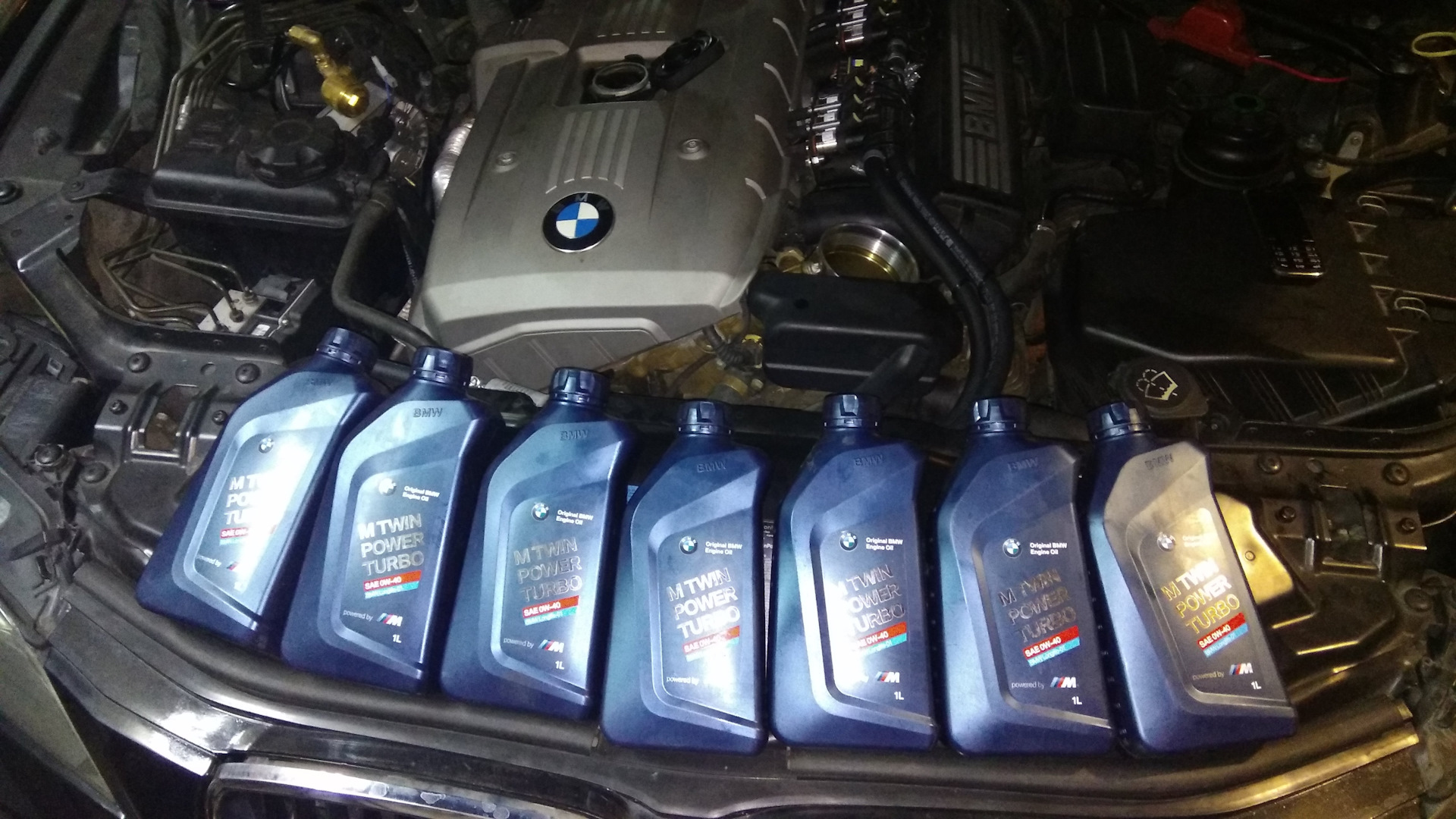 Therefore, with this mode of operation, it is advisable to change the oil every 7-8 thousand km.
Therefore, with this mode of operation, it is advisable to change the oil every 7-8 thousand km.
If we are talking about a “weekend car”, in which the owner goes to the country along not very busy country roads, then here you can focus on the mileage. And change the oil every 15 thousand km, as prescribed by the manufacturer.
This advice is not for those who drive with a heavy trailer or on mountain roads: in such cases, the manufacturer’s recommended replacement interval should be halved.
If the car practically does not go anywhere, then you still need to change the oil once a year. In the engine, it oxidizes and, therefore, deteriorates. It would last longer in a sealed canister, since the amount of oxygen in it is limited. It is clear that if you do not change the oil for a couple of years, the engine will still start. But the characteristics of the oil will already differ from the original ones, which will lead to a decrease in engine life.
Low oil — is it dangerous?
If the oil level is at the minimum level, you can drive. However, this is comparable to the third call before the performance: hurry up to top up! It is harder for the oil to work under such conditions than at the nominal level, since the so-called multiplicity of its exchange increases (in other words, the same particles of it have to work harder). Accordingly, it ages faster and ceases to perform its functions ahead of time.
However, this is comparable to the third call before the performance: hurry up to top up! It is harder for the oil to work under such conditions than at the nominal level, since the so-called multiplicity of its exchange increases (in other words, the same particles of it have to work harder). Accordingly, it ages faster and ceases to perform its functions ahead of time.
Oil leaked — what to do?
Should the oil filter be filled with oil before installation?
If some obscene drop hangs on the engine dipstick, resembling either tar or mucus in its consistency, change the oil immediately!
It does no good. Moreover, only on a part of automobile engines the filter is installed with the connector up, and in the vast majority — horizontally or at an angle. When installing, the oil will still pour out, and even the motor will have to be cleaned. And you will not find such a recommendation in any manual for the car.
- «Behind the wheel» can also be read in Odnoklassniki.

Is it possible to drive if the oil level in the car engine is below the minimum level — Lifehack
- Lifehack
- Operation
Engine oil is necessary for the engine to lubricate moving parts, which, in turn, reduces their wear. Thanks to oils, which in themselves are a very complex chemical compound, the resource of the power unit increases. But what if the engine does not have enough lubrication? And can you go?
Zatvornaya Lika
Various components of motor oils affect their lubricating properties, resistance to burnout, high and low temperatures, fluidity and other properties. In other words: it is the blood of the heart of your car. And the health of the engine depends on what it is, in what condition and how much it is filled in.
But, as they say, nothing lasts forever under the moon. Motors break down, and oil miraculously burns out, evaporates, burns out, or partially escapes through any gap in the oil system.
 By the way, many automakers do not even hide the fact that their engines consume oil, and write in the operating instructions about the need for periodic monitoring of its level and topping up.
By the way, many automakers do not even hide the fact that their engines consume oil, and write in the operating instructions about the need for periodic monitoring of its level and topping up. For example, VAG turbo engines with a volume of 1.8 liters quite routinely allow themselves to eat up to 500 grams of oil per 1000 kilometers. The “beam” aspirated V8 with a volume of 4.8 liters, being in good condition, takes up to 1 liter of oil per 1000 km for waste. The same story with the engines of Subaru, Mercedes-Benz, Ford, Mazda and engines of other automakers.
But who reads the instructions? Sat down and went. They told me to come to MOT at 10, 15, 20 thousand kilometers — I arrived. But in the interval between maintenance, not many look under the hood. And those who look, at times, are very surprised that the oil level in the engines of their cars is at a minimum, or even lower. And here a logical question arises: is it permissible to drive a car if the oil in the engine is at a minimum level?
Answer: if there are no visible and strong oil leaks, then you can go.
 The thing is that the oil pump with the intake is located much lower than the dipstick — in the crankcase. And the oil pressure has nothing to do with its level in the sump. Therefore, a dry dipstick does not mean at all that your engine lacks lubrication. This means that you can drive to a service or a store where you can buy oil of the brand that is recommended for your car’s engine, and simply top it up.
The thing is that the oil pump with the intake is located much lower than the dipstick — in the crankcase. And the oil pressure has nothing to do with its level in the sump. Therefore, a dry dipstick does not mean at all that your engine lacks lubrication. This means that you can drive to a service or a store where you can buy oil of the brand that is recommended for your car’s engine, and simply top it up. The main thing is not to sink the “slipper” into the floor and not bring it to the point where the oiler icon starts to burn constantly, and even worse, the oil pressure control lamp in the engine lights up. Here the operation of the car is prohibited at all. Otherwise, the motor will simply die.
135183
- Society
- Society
The Italian «heel» helps to live and earn money
32881
- Society 9 0032
- Social
Italian «heel» helps to live and earn
32881
Subscribe to the channel «Avtovzglyad»:
- Telegram
- Yandex.

